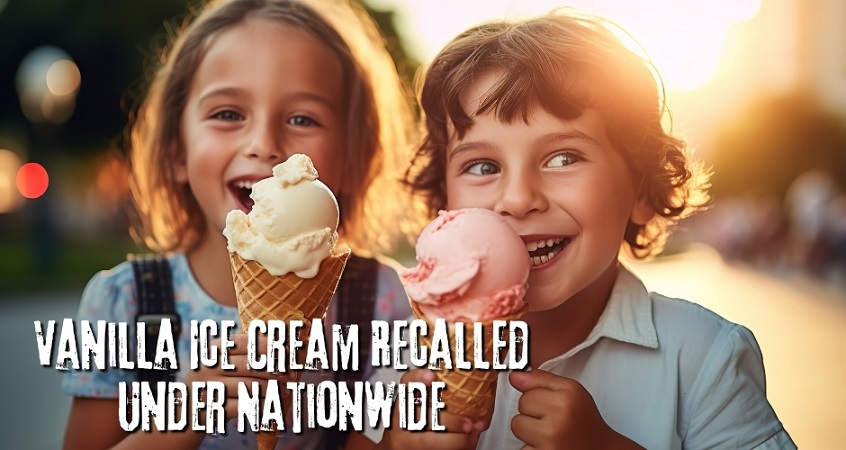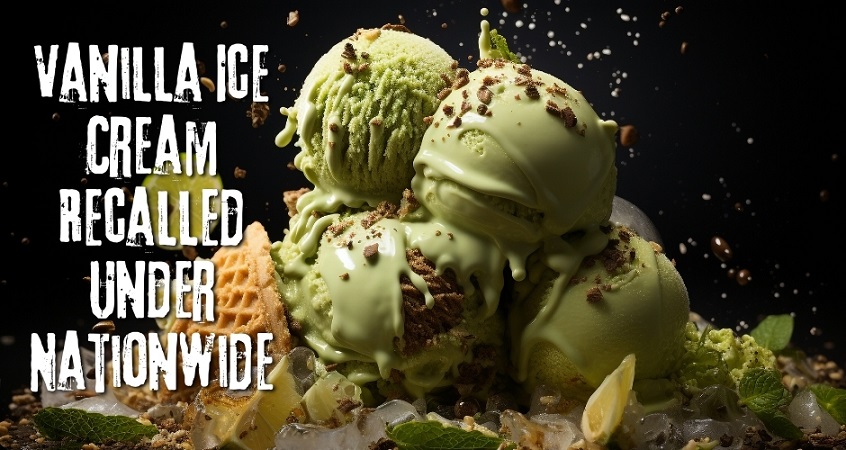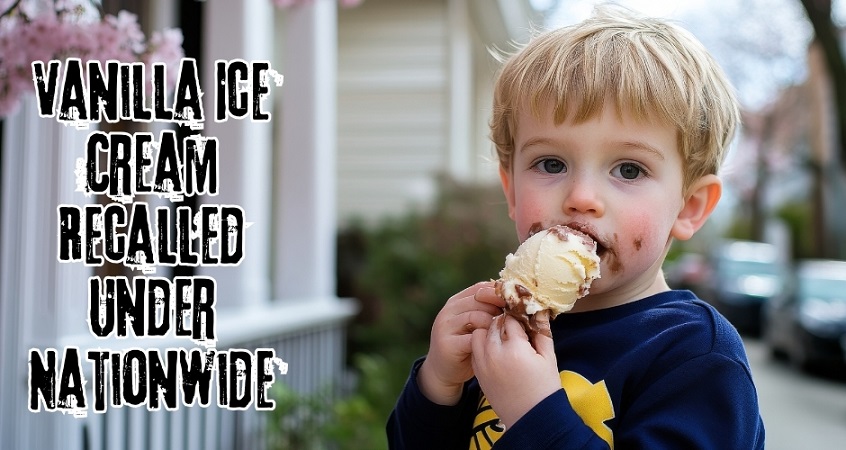Introduction
Vanilla Ice Cream Recalled It’s a sultry summer afternoon in July, the sun pounds, and you grab your go-to vanilla ice cream from your freezer—only to find that it’s subject to a national recall. In May of 2025, United States consumers were shocked when Wells Enterprises issued a voluntary recall of over 16,000 gallons of vanilla ice cream and frozen yogurt items due to possible plastic contamination in each 3-gallon package. The release—designated by the FDA as a Class II recall—identified mouth injuries or choking risks if plastic fragments are found. This blog post dives deep into the Vanilla Ice Cream recalled Nationwide event: tracing its origins, unpacking the health implications, examining industry practices, and offering guidance on what to do if you’ve purchased an affected product.

1. Timeline & Scope of the Recall
- April 2025: Wells Enterprises, manufacturer of Blue Bunny, Halo Top, and certain private label products, confirmed findings of “hard plastics” in samples of products.
- May 1, 2025: The firm conducted a voluntary U.S. nationwide recall of 22 SKUs in five brands, shipped to more than 103 foodservice institutions across 48 states.
- Products affected are:
- Blue Bunny Vanilla Ice Cream (3-gal tubs)
- Gordon Choice Vanilla Flavored Ice Cream
- Glenview Farms Vanilla Frozen Yogurt
- Keith Valley Vanilla Ice Cream
- Ellington Farms Vanilla Ice Cream
| Brand | Units Recalled | Distribution Channels | Food-service distributors |
|---|---|---|---|
| Blue Bunny | 5,280 tubs | Restaurants, cafeterias, hotels | 07/2026 – 10/2026 |
| Gordon Choice | 1,080 tubs | Food‑service distributors | 08/2026 – 09/2026 |
| Glenview Farms | 1,573 tubs | University cafeterias, caterers | 06/2026 – 09/2026 |
| Keith Valley | 569 tubs | Hospital cafeterias | 05/2026 – 08/2026 |
| Ellington Farms | 600 tubs | Chain restaurants | 03/2026 – 07/2026 |
Data taken from Wells Enterprises recall notice and FDA archive.

2. Health Hazards & FDA Rating
The FDA ranked this as a Class II recall, meaning ingestion of, or exposure to, the recalled product has the potential to result in temporary or medically reversible harmful health effects—but there is a low probability of significant side effects. The most serious risks are :
- Oral Injuries: Sharp plastic fragments may cut the tongue, gums, or palate.
- Dental Damage: Sharp fragments can possibly chipped or crack teeth.
- Choking Hazard: Especially for kids, tiny fragments have the possibility of causing airway blockage.
No injuries or illnesses were reported upon issuance of the recall, but because of possible adverse events, authorities and consumer groups requested unconditional compliance.
3. Root Causes & Manufacturing Insights
Wells Enterprises attributed the contamination to a production error at its plant in Iowa, where a plastic component of a mixing auger disintegrated during use, as per its notice of recall. Internal investigations revealed:
- Material Fatigue: Due to extended use, the plastic bushing of a line mixer in production wore out faster than anticipated.
- Inadequate Inspection Interval: Routine maintenance did not include inspections of non-metallic wear parts.
- Pressures of Rapid Expansion: Post-pandemic demand for frozen desserts was up 35% in 2024, necessitating extended shift hours and extended deep clean cycles.
Industry Viewpoint: Food manufacturing specialists point out that nonmetallic parts of equipment are frequently the “unseen” components within metal detection systems, underlining the importance of a valid hazard analysis as part of HACCP (Hazard Analysis and Critical Control Points) programs.

4. Industry Comparisons: How Common Are Frozen Dessert Recalls?
Over the past decade, the frozen dessert sector has seen approximately 15 major recalls related to contamination—ranging from Listeria in ice cream cakes (2015–2018) to undeclared allergens in gelato (2022). Compared to these, plastic contamination is less common but not unprecedented:
| Year | Company | Product | Contaminant | Recall Type |
|---|---|---|---|---|
| 2015 | Brand X | Chocolate Ice Cream Cake | Listeria | Class I |
| 2018 | Brand Y | Mixed Fruit Sorbet | Glass shards | Class I |
| 2022 | Artisanal Gelato Co. | Strawberry Gelato | Milk (allergen) | Class II |
| 2025 | Wells Enterprises | Vanilla Ice Cream & Yogurt | Plastic fragments | Class II |

5. Consumer Advice: What to Do If You Purchased Recalled Ice Cream
- Check Your Freezer: Compare UPCs and batch numbers with the FDA recall list.
- Do Not Eat: Take the product back to the store in which you purchased it for a full refund or safely dispose of it.
- Get Medical Assistance: In case you or anyone near you feels pain, cuts, or suspected swallowing, seek the opinion of a medical professional at once.
- Remain Informed: Get FDA recall alerts and stay tuned to Wells Enterprises updates.
Personal Note: Having found tubs in my freezer, I called customer service and received a prepaid return label—emphasizing the importance of open recall procedures in preserving consumer trust.

6. Wider Implications for Food Safety
6.1 Upgrading Detection Technologies
- X ray vs. Metal Detection: Sourcing to employ combined X-ray inspection to detect plastic, ceramic, and bone particles.
- Vision Systems: AI-based cameras can detect nonmetallic hazard controls through shape and color anomalies.
6.2 Upgrading Regulatory Surveillance
- FDA Modernization Plan: Suggestions to require nonmetallic hazard controls in high-risk product types such as dairy and frozen desserts.
- Third Party Audits: NSF and BRC Global Standards regular unannounced plant visits.
6.3 Consumer Empowerment & Transparency
- Groups such as Food Safety Watch support real-time recall notifications on retail apps and smart fridge platforms.
7. Key Insights & New Perspectives
- Supply Chain Sophistication: This recall demonstrates the way one component failure can cascade across an entire supply chain from raw material providers to dinners across millions of tables.
- Brand Reputation Exposure: Even established brands such as Blue Bunny may face drastic loss of brand equity if recalls are not initiated early and openly.
- Technological Leverage: New-generation detection and predictive maintenance technologies are the future in preventing such recalls in the first place.

Conclusion
Nationwide-recalled vanilla ice cream in 2025 is more than a temporary inconvenience—it’s an exercise in the suspense of food safety regulation. From factory root cause analysis to consumer advice and technological barrier measures, we are all complicit in making our standby delights safe. When you take that next bite, take note of the stringent processes—and periodic glitches—that fuel the humble delight of vanilla ice cream.
Call to Action
Did you have a problem with the vanilla ice cream recall? Tell us about it in the comments, subscribe to instant recall notices, and read our Home Food Safety Best Practices guide to save your freezer—and your family.




